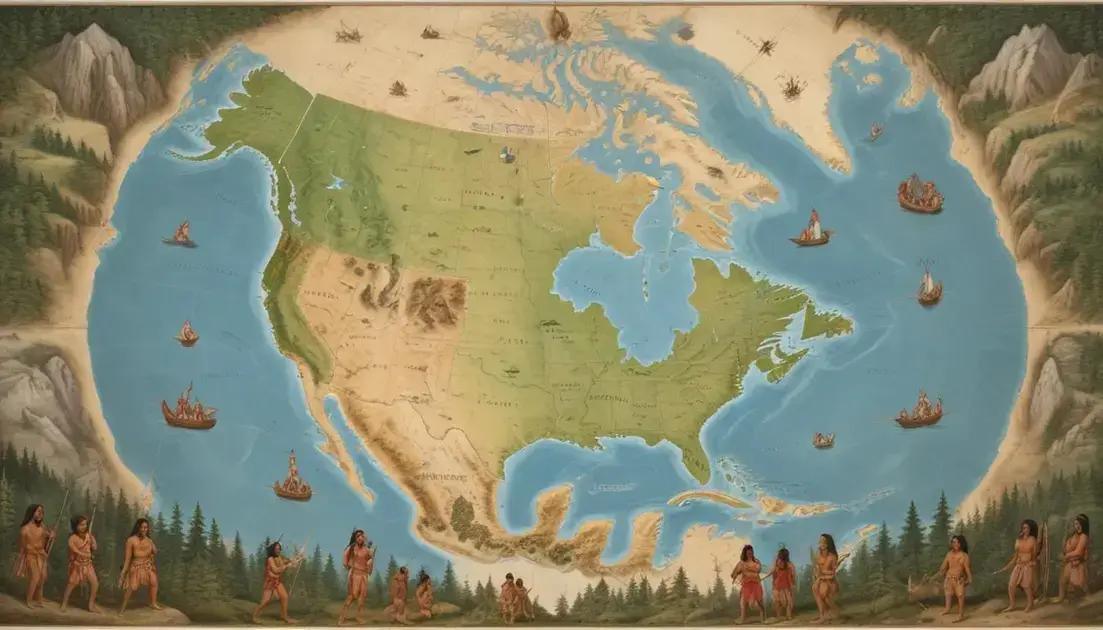
Indigenous Discoveries: The Map Before the Europeans
Indigenous mapping practices are rich in cultural significance and offer valuable lessons on environmental respect and community collaboration. These practices highlight the deep connections Native Americans have with their land, showcasing their holistic understanding of nature and the importance of sharing knowledge across generations. By learning from these methods, we can foster sustainable living and a greater appreciation for diverse cultures, ultimately promoting environmental stewardship and community involvement.
Did you know that Indigenous Discoveries occurred long before Europeans set foot on this land? Many native tribes were already mapping their territories, showcasing a rich history that often goes untold. Curious to learn more? Dive in!
The rich landscapes of Native America
Native America is home to stunning landscapes that vary from mountains to forests and plains. Each region holds its own beauty and significance. These rich landscapes shaped the lives of the indigenous peoples who lived there long before European settlers arrived.
Mountains and Valleys
In the West, the Rocky Mountains rise majestically. These mountains provided resources like animals and plants. They also served as natural barriers and sacred sites. The views from the peaks can take your breath away!
Forests and Rivers
The forests of the North are teeming with life. Tall trees provide shelter and materials for homes and tools. Rivers flow through these lands, offering fish and water, vital for survival. Many tribes learned to thrive in harmony with nature.
Plains and Deserts
The Great Plains stretch for miles, showcasing grasslands perfect for hunting bison. The resilience of the tribes in these areas is remarkable. They adapted to the hard climate while maintaining their traditions. In contrast, the deserts of the Southwest offer unique plants and animals, demonstrating life’s versatility.
Every landscape has stories carried through generations. The respect for nature seen in Native American cultures continues today. They teach us to appreciate and protect these beautiful places that have been home for thousands of years.
Mapping the territories: Pre-European insights
Mapping territories was a vital practice for Native Americans long before Europeans arrived. These pre-European insights helped tribes understand their land and resources. They created maps based on their oral traditions, showing important locations.
Oral Traditions and Storytelling
Tribes relied on oral histories to pass down knowledge. Stories included routes, seasonal changes, and places for hunting. This knowledge was crucial for survival and was shared through generations.
Natural Landmarks
Natural landmarks served as guides in the landscape. Rivers, mountains, and unique rock formations helped people find their way. These features were like signs, showing directions and important sites for gathering.
Exchanges and Trade Routes
Native Americans also had maps for trade routes. They exchanged goods with nearby tribes, understanding the paths to travel for trade. This system built connections and helped communities thrive through sharing resources.
Mapping was not just about directions; it was about respecting the land and its stories. The insights gained from these maps were essential for daily life and maintaining their culture.
Cultural significance of indigenous exploration
Indigenous exploration holds deep cultural significance. It reflects the values and connections of Native American tribes to their land. Understanding this cultural significance helps us appreciate their rich history.
Connection to the Land
For indigenous peoples, land is more than just a place. It is part of their identity and spirituality. Exploring their territories allowed them to learn and respect the environment.
Passage of Knowledge
Exploration was not just physical; it included sharing knowledge. Elders taught younger generations about survival, traditions, and the land’s gifts. This knowledge was essential for thriving.
Storytelling and Traditions
Every journey had a story. Indigenous explorations were often tied to legends and cultural practices. These stories helped maintain their history and shape their identity across generations.
Understanding the cultural significance behind exploration reveals a world of knowledge and connection. It shows how deeply intertwined these communities are with their environment and history.
Lessons from indigenous mapping practices
Indigenous mapping practices offer valuable lessons that we can learn from today. These practices show how closely connected people are to their land. Understanding these lessons can help us appreciate diverse cultures and their wisdom.
Holistic Understanding
Indigenous maps often reflect a deep understanding of the environment. They include details like animal migration and plant seasons. This holistic view emphasizes the importance of every part of nature.
Community Involvement
Mapping was not done alone. It involved the whole community. Elders, hunters, and gatherers all contributed their knowledge. This collaboration strengthened bonds and ensured everyone’s knowledge was used.
Adaptability
Indigenous mapping practices also show adaptability. As environments changed, so did their maps. They updated routes and resource locations based on new insights. This ability to adapt is crucial for survival.
By learning from these practices, we gain insights into sustainable living. We see the value in connecting with our environment and working together as a community.
Conclusion
In conclusion, learning from indigenous mapping practices offers valuable insights into our connection with the land. These practices show us the importance of community and understanding our environment. They remind us that mapping isn’t just about directions; it reflects a deep respect for nature.
By embracing these lessons, we can work together to create more sustainable ways of living. Understanding the past helps us appreciate the present and build a better future. Let’s honor indigenous wisdom and apply it to our modern lives, ensuring we protect our planet for generations to come.

